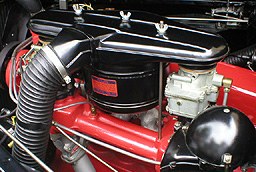In the last thread, I wondered how many WCD sizes there were and what CFM they might be.
Here is what I have on sizes, along with my guess at CFM though Im not sure these were ever CFM rated (usually 1-2bbls are rated at 3 Hg, 4bbls are rated at 1.5 Hg I number crunch everything at 1.5 Hg for consistency)
Venturi
.Throttle
CFM@3Hg
.CFM@1.5Hg
7/8
.
.1-1/4
......160
..115
.41-42 buick 248
1-1/16
1-1/4
....221
.160
..41-46 buick 320
1-3/16
1-7/16
...311
.223
.41-49 buick, olds, Pontiac, 53 Chrysler
Not sure if you can confirm or add to any of this, Im just trying to build a carb/cfm database over the years.
Thanks for the shout Deuce . . . glad you're a fan of 216s - not to mention it's nice to be appreciated.
Regarding the question on applications for the Carter WCD I think you will find that they are quite numerous. This site summarizes nicely:
Carburetor Blog seems Carter was being commissioned to create new castings (with subtle tweaks on the basic design) by many different car makers over the years.
They even took on a special build for the Buick Compound Carburetion setup - when Buick decided to drop the pricey Stromberg Aero pots used previously in this unique progressive design:
Carbkit Source 
I like the WCD for dual carb setups because it has a mechanical accelerator pump (as opposed to a vacuum driven power valve design) as vacuum will likely be in shorter supply with two holes opened to the atmosphere :-)
As for the question of CFM rating - this is a veritable can of worms. Panic doesn't come around here much anymore - but he's spot-on in that there are too many variables involved in comparing carbs based on some published CFM rating (which was ultimately for a specific application and may have been hyped).
The Carb Shop does a good job in describing the problems with these 'advertised' CFM specs (dry, wet, 3" versus 1.5" sustained vacuum etc.)
The Carburetor Shop But this is just the beginning of the conundrum. CFM demands are function of the displacement of the engine, timing of valve events from the cam, volumetric efficiency and an operating RPM band.
With these variables in mind, if one fits a carb that is quote-un-quote TO SMALL (for the capabilities of the engine underneath) the result will be higher CFM rates through the carb throat (then advertised) at a higher vacuum reading (the latter creating good throttle response). Most OEM applications involved fitting a carb that was technically "smaller" then the demands/capabilities of the engine. Here in lies the opportunity to Hop Up.
This leads to the whole discussion of fitting duals or trips and the sixty-four-thousand-dollar question: "what size carb should I use" . . . for me published CFM ratings seem like the last thing to look at.
Instead I think we need to look toward the geometry in the carb body - specifically the venturi area and the flange area or throttle bore area. When switching from a single carb to dual it is important that the venturi area of the individual carbs be smaller then the original fitment. This preserves vacuum.
For example, in moving from a Carter W1 to dual WCDs the venturi area goes from 1.23" to 2x .887" or 1.77" - this is a 44% increase venturi area (as opposed to doubling - which is what you'd get with two W1s). Venturi area is the best indicator of pressure drop and therefore vacuum at various CFM. So when splitting an egines CFM demands between two carbs the venturi area now needs to be sized/measured in concert.
Moreover, the venturi area can be used to compare carburetors of similar flow capabilities. I find the Victory Tech Papers to be quite insightful in this regard. In this case the author is attempting to infer CFM as function of venturi size/area - assuming a bench mark smooth flowing Amal GP carb in a blow through super charged application:
Victory Tech Papers his work yields a coefficient of 133 x venturi area = CFM (for the bench mark carb). This might well be an angle for Gonkulator . . . based on bench mark data from inline sixes . . .
The next variable to consider is the flange or throttle area. There is an excellent discussion about this topic at this Porsche site
Performance Oriented which includes formulas for calculating optimal throttle bore size and venturi sizes. It assumes one throat per cylinder (german engineering) though when applying the calculations to an I6 stovebolt the results seem over carbed.
Not sure how to translate these one throat/venturi per cylinder calculations into a shared a plenum design . . . or if it is even possible. But I am intrigued by the arithmetic.
What the math suggests to me is that the throttle bore area translates directly to CFM 'capability' of a carb - or in the case of a dual - two carbs in concert. But the engine underneath needs to be able to use the available area. The ratio of venturi area to throttle area translates into vacuum signal. If the carb being fitted includes features that are dependent on vacuum - fitting to large a venturi seems more a foul then fitting to large a throttle area (which can ultimately be controlled by the foot feed).
regards,
stock49

